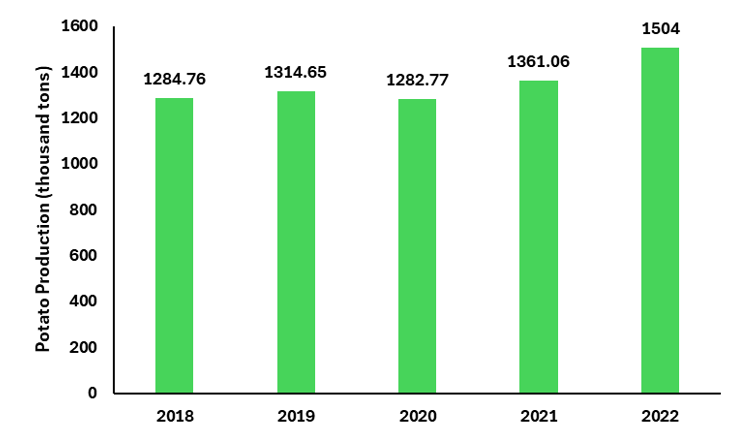Effectiveness of Bacillus subtilis (Ehrenberg) Cohn. to Suppress the Intensity of Dry Spot Disease (Alternaria solani sor.) on Potato Plant (Solanum tuberosum L.)
Main Article Content
Lilis Irmawatie
Rizki Nasrullah
Suli Suswana
Rosyad Nurdin
Ida Adviany
Background: Potato (Solanum tuberosum L.) is one of the priority horticultural crops to be developed in Indonesia. One of the factors affecting the decline in potato productivity is Plant Disturbing Organisms (PDO), namely Alternaria solani Sor. a pathogenic fungus that causes dry spot disease in potato plants. Infection by this disease can reach 100%, resulting in yield losses of up to 78%. One of the biological agents utilized is Bacillus subtilis (Ehrenberg) Cohn. the bacteria for controlling Alternaria solani Sor.
Aims: This study aims to determine the effectiveness and optimal concentration of Bacillus subtilis (Ehrenberg) Cohn in suppressing the intensity of Alternaria solani Sor—disease on potato plants.
Methods: The research was conducted using the Randomized Block Design (RBD) method, consisting of 6 treatments and 5 replications. The treatment applications used were: Bs-8 (Bacillus subtilis (Ehrenberg) Cohn. 8 ml/liter of water), Bs-10 (Bacillus subtilis (Ehrenberg) Cohn. 10 ml/liter of water), Bs-12 (Bacillus subtilis (Ehrenberg) Cohn. 12 ml/liter of water), Bs-14 (Bacillus subtilis (Ehrenberg) Cohn. 14 ml/liter of water), B1 (Positive control 80% mankozeb concentration 2 grams/liter of water), and B0 (Negative control without Bacillus subtilis (Ehrenberg) Cohn.).
Result: The results showed that Bacillus subtilis (Ehrenberg) Cohn. treatment suppressed the intensity of dry spot disease (Alternaria solani Sor.), and the concentration of Bacillus subtilis (Ehrenberg) Cohn. 14 ml/liter effectively suppresses the intensity of Alternaria solani Sor. disease by 88.89% in potato plants.
Badan Pusat Statistik (BPS). (2022). Statistik hortikultura 2022.
Baihaki, A. (1999). Rancangan dan analisis percobaan. Fakultas Pertanian Universitas Padjadjaran.
Batool, T., Ali, S., Seleiman, M. F., Naveed, N. H., Ali, A., Ahmed, K., Abid, M., Rizwan, M., Shahid, M. R., Alotaibi, M., Al-Ashkar, I., & Mubushar, M. (2020). Plant growth promoting rhizobacteria alleviates drought stress in potato in response to suppressive oxidative stress and antioxidant enzymes activities. Scientific Reports, 10(1), 16975. https://doi.org/10.1038/s41598-020-73489-z
Goodstats. (2023). Produksi Kentang Di Indonesia Naik Secara Bertahap - GoodStats Data. GoodStats Data. Retrieved from https://data.goodstats.id/statistic/elmaarmavillia/produksi-kentang-di-indonesia-naik-secara-bertahap-P6HbQ
Gultom, L. S., & Gea, D. Z. 2020. Analisis Agribisnis Kentang (Solanum tuberosum L) Desa: Merek, Kecamatan Merek, Kabupaten Karo, Provinsi Sumatera Utara. 28 (2).
Hersanti, Safitri, N., Djaya, L., & Sianipar, M. S. (2020). Kemampuan Bacillus subtilis dan Trichoderma harzianum dalam Campuran Serat Karbon dan Silika Nano untuk Meningkatkan Ketahanan Tanaman Padi terhadap Penyakit Blas (Pyricularia oryzae). Jurnal Agrikultura, 2020(3), 182–192.
Irmawatie, L., Adviany, I., Maulana, D. D., & Khairi, W. A. L. Z. (2023). Pengujian Konsorsium Mikroba dalam Upaya Menekan Intensitas Penyakit Hawar Daun (Botrytis squamosa Walker.) pada Tanaman Bawang Merah (Allium ascalonicum L.). Agrotrop: Journal on Agriculture Science, 13(2), 157–169.
Istiqomah, & Kusumawati, D. E. (2018). Pemanfaatan Bacillus subtilis dan Pseudomonas fluorescens dalam pengendalian hayati Ralstonia solanacearum penyebab penyakit layu bakteri pada tomat. Jurnal AGRO, 5(1), 1–12. https://doi.org/10.15575/2305
Kantar, F., & Uysal, A. (2020). Effect of Bacillus subtilis and Bacillus amyloliquefaciens culture on the growth and yield of off-season potato (Solanum tuberosum L.). Acta Agronómica. https://doi.org/10.15446/acag.v69n1.73832
Kumar, M., Dabas, M. R., Kumar, D., & Kumar, A. (2022). Prevalence, isolation, cultural and morphological characterization of early blight (Alternaria solani) of tomato from Uttar Pradesh. The Pharma Innovation Journal, 11(11), 577–582.
Madhi, Q. H., & Jumaah, A. M. (2020). Affectivity evaluation of Bacillus subtilis in controlling eggplant root rot caused by Rhizoctonia solani and Fusarium solani. IOP Conference Series: Earth and Environmental Science, 553(1), 012026. https://doi.org/10.1088/1755-1315/553/1/012026
Munthali, C., Kinoshita, R., Onishi, K., Rakotondrafara, A., Mikami, K., Koike, M., Tani, M., Palta, J., & Aiuchi, D. (2022). A model nutrition control system in potato tissue culture and its influence on plant elemental composition. Plants (Basel), 11(20), 2718. https://doi.org/10.3390/plants11202718.
Mutakin, D. J. (2018). Pengaruh Konsentrasi Bacillus subtilis (Ehrenberg) Conh. Terhadap Perkembangan Alternaria solani Sorauer Penyebab Penyakit Bercak Daun pada Tanaman Kentang (Solanum tuberosum L.) Di Cetespong Lembang.
Polyakova, M. (2023). Managing Potato Alternaria: Strategies for Prevention and Control. Potato News. Available at: https://potatoes.news/early-blight-in-agriculture-understanding-alternaria-solani-and-its-impact-on-crop-yield/ [Accessed 20 Oct. 2023].
Prihatiningsih, N., Arwiyanto, T., Hadisutrisno, B., & Widada, J. (2019). Mekanisme antibiosis Bacillus subtilis B315 untuk mengendalikan penyakit layu bakteri kentang. Jurnal HPT Tropika, 15(1), 64–71.
Prima, T. A., Lianti, A. D., Munthe, B. T., Retno, D. A., Revina, G., Yasmin, E., Studi, P., Tanaman, P., Sriwijaya, F., & Sriwijaya, U. (2020). Pengujian biofungisida berbasis mikroorganisme antagonis untuk pengendalian penyakit busuk umbi pada kentang. Prosiding Seminar Nasional Lahan Suboptimal ke-8 Tahun 2020, 978–979
Sharma, R. K., Patel, J. K., Patel, D. R., & Patel, R. N. (2020). Management of early blight of potato (Solanum tuberosum L.) caused by Alternaria solani [(Ellis & Martin) Jones & Grout] through fungicides and its impact on yield. International Journal of Current Microbiology and Applied Sciences, 9(3), 1683–1693. https://doi.org/10.20546/ijcmas.2020.903.196
Slepecky, R. A., & Hemphill, H. E. (2019). The Genus Bacillus—Nonmedical. Dalam A. Balows, H. G. Truper, M. Dworkin, W. Harder, & K.-H. Schleifer (Eds.), The prokaryotes (2nd ed., Vol. 1, pp. 1663–1696). Springer-Verlag
Sun, Y., Su, Y., Meng, Z., Zhang, J., Zheng, L., Miao, S., Qin, D., Ruan, Y., Wu, Y., Xiong, L., Yan, X., Dong, Z., Cheng, P., Shao, M., & Yu, G. (2023). Biocontrol of bacterial wilt disease in tomato using Bacillus subtilis strain R31. Frontiers in Microbiology, 14, 1281381. https://doi.org/10.3389/fmicb.2023.1281381
Wang, X. Q., Zhao, D. L., Shen, L. L., Jing, C. L., & Zhang, C. S. (2018). Application and mechanisms of Bacillus subtilis in biological control of plant disease. In P. K. Singh, V. P. Singh, & S. M. Prasanna (Eds.), Role of rhizospheric microbes in soil: Stress management and agricultural sustainability (Vol. 1, pp. 225–250). Springer Singapore. https://doi.org/10.1007/978-981-10-8402-7_9
Yuldashova, Z. Z., Sodikov, B. S., & Khamiraev, U. K. (2023). Alternaria disease of potato and its control (Review). EPRA International Journal of Research and Development (IJRD), 8(5). https://doi.org/10.36713/epra13285
Zhang, D., Qiang, R., Zhou, Z., Pan, Y., Yu, S., Yuan, W., Cheng, J., Wang, J., Zhao, D., Zhu, J., & Yang, Z. (2022). Biocontrol and action mechanism of Bacillus subtilis lipopeptides' fengycins against Alternaria solani in potato as assessed by a transcriptome analysis. Frontiers in Microbiology, 13, 861113. https://doi.org/10.3389/fmicb.2022.861113








